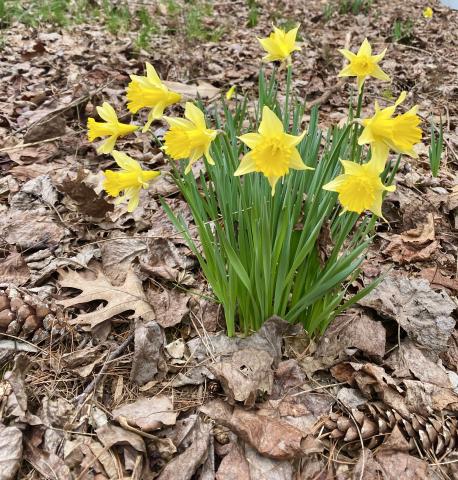Daffodils are the Harbingers of Spring
By Steve Roark
Volunteer, Cumberland Gap National Historical Park
Nothing says Springs-a-comin’ like seeing Daffodils spotting the countryside. They are of particular interest to me because I’m a mountain history nerd, and they often point to old cabin sites that I like to check out when I’m out exploring
Daffodils are in the genus Narcissus, which is also another common name for the flower, along with Jonquil. The name Daffodil came from the Dutch, who called it “affo dyle’, which means “that which comes early”, very proper. The name Narcissus came from the Greek word narkotikos, which meant “numbness”, referring perhaps for its use as a medicinal. Think “narcotic”. The name Jonquil was derived from the Spanish work “Junquillo”, which means “rush”, referring to its skinny rush-like foliage.
The flower is unique and super easy to identify, being bright yellow and having 6 petals and a central horn-like structure referred to as a corona. This houses the sex organs of the flower and is a structure not uncommon in the plant world.
The Daffodil originated as a native plant growing in southwestern Europe, in the Iberian Peninsula and northern Africa. The Roman Army was responsible for its spread into Britain and every place else they invaded. It was believed to have healing properties, and so was carried along by Roman apothecaries (think druggist) wherever the army was stationed. The juice of the plant was used to treat cuts and bruises. The plant is considered toxic however, and consuming the bulbs has led to deaths.
From Britain the Daffodil was carried to the American Colonies because they were so popular, and because the bulbs traveled well and survival upon planting is pretty good. They gradually spread to the eastern seaboard and here in the Appalachians, where early settler wives planted them in flower gardens, which often remain long after the cabin home has melted away in time. Left undisturbed these old plantings have spread by producing additional bulbs and often formed large eye catching colonies.
While stomping around the mountains I tun across Daffodils around old homesteads and cemeteries. Besides the common yellow daffodil, I have found a couple more varities worth noting. One with 400-year history is the Double Daffodil, which looks like two normal daffodils smooshed together and the trumpet-like corona is not visible. This flower is properly called the Van Sion Heirloom Double Daffodil, named for one Vincent Sion, who managed to obtain some bulbs propagated them in his garden as early as 1620. They eventually made to Holland where the Dutch mass produced them. They can be found in the heirloom flower gardens of Colonial Williamsburg
Another variety I regularly find is the Pheasant’s Eye, which has a slimmer corona with a touch of red along the lip. My grandmother grew these and there are still a few growing along a woodland edge near her old home site. Pheasant’s Eye goes way back to ancient times, often referred to as the Narcissus of ancient times.
- Log in to post comments
